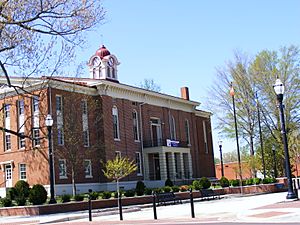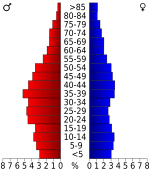Hardeman County, Tennessee facts for kids
Quick facts for kids
Hardeman County
|
|
|---|---|

Hardeman County Courthouse in Bolivar
|
|

Location within the U.S. state of Tennessee
|
|
 Tennessee's location within the U.S. |
|
| Country | |
| State | |
| Founded | 1823 |
| Named for | Thomas J. Hardeman |
| Seat | Bolivar |
| Largest city | Bolivar |
| Area | |
| • Total | 670 sq mi (1,700 km2) |
| • Land | 668 sq mi (1,730 km2) |
| • Water | 2.6 sq mi (7 km2) 0.4%% |
| Population
(2020)
|
|
| • Total | 25,462 |
| • Density | 41/sq mi (16/km2) |
| Time zone | UTC−6 (Central) |
| • Summer (DST) | UTC−5 (CDT) |
| Congressional district | 8th |
Hardeman County is a county located in the U.S. state of Tennessee. As of the 2020 census, the population was 25,462. Its county seat is Bolivar.
Contents
History
Hardeman County was created by the Tennessee General Assembly in 1823 from parts of Hardin County and "Indian lands." It is named for Thomas J. Hardeman (1788-1854), a veteran of the Creek War and the War of 1812 and a prominent figure in the fight for Texas independence. He served as a congressman in the Republic of Texas, and was also the father of Confederate brigadier general William Polk Hardeman.
Settlers began arriving in the area that is now Hardeman County in 1819, following a treaty with the Chickasaw allowing settlement in West Tennessee signed on October 19, 1818. Among these earliest settlers were the county's namesame Thomas Hardeman and Ezekiel Polk, the paternal grandfather of president James K. Polk. Thereafter, further settlers arrived from Middle Tennessee, Alabama, North and South Carolina, and Virginia.
The first permanent settlement was established in 1823 along the Hatchie River, dubbed Hatchie Town. The town's location along the river led to recurrent flooding, and ultimately the decision was made to relocate the settlement approximately one mile south to what is now Bolivar.
Hardeman County was the site of several battles and skirmishes in the Civil War. The largest of these was the Battle of Hatchie's Bridge which took place on October 5, 1862 and resulted in 900 total casualties. Much of downtown Bolivar was also burned down during the war. The town of Grand Junction was the site of the first contraband camp, organized by John Eaton to shelter and employ enslaved individuals captured by the Union.
The county is the location of two of Tennessee's four private prisons, the Whiteville Correctional Facility and the Hardeman County Correctional Center. Both are medium-security facilities for men, operated by the Corrections Corporation of America.
Geography
According to the U.S. Census Bureau, the county has a total area of 670 square miles (1,700 km2), of which 668 square miles (1,730 km2) is land and 2.6 square miles (6.7 km2) (0.4%) is water. It is the fifth-largest county in Tennessee by area.
Adjacent counties
- Madison County (north)
- Chester County (northeast)
- McNairy County (east)
- Alcorn County, Mississippi (southeast)
- Tippah County, Mississippi (south)
- Benton County, Mississippi (southwest)
- Fayette County (west)
- Haywood County (northwest)
National protected areas
State protected areas
- Chickasaw State Park (part)
Demographics
| Historical population | |||
|---|---|---|---|
| Census | Pop. | %± | |
| 1830 | 11,655 | — | |
| 1840 | 14,563 | 25.0% | |
| 1850 | 17,456 | 19.9% | |
| 1860 | 17,769 | 1.8% | |
| 1870 | 18,074 | 1.7% | |
| 1880 | 22,921 | 26.8% | |
| 1890 | 21,029 | −8.3% | |
| 1900 | 22,976 | 9.3% | |
| 1910 | 23,011 | 0.2% | |
| 1920 | 22,278 | −3.2% | |
| 1930 | 22,193 | −0.4% | |
| 1940 | 23,590 | 6.3% | |
| 1950 | 23,311 | −1.2% | |
| 1960 | 21,517 | −7.7% | |
| 1970 | 22,435 | 4.3% | |
| 1980 | 23,873 | 6.4% | |
| 1990 | 23,377 | −2.1% | |
| 2000 | 28,105 | 20.2% | |
| 2010 | 27,253 | −3.0% | |
| 2020 | 25,462 | −6.6% | |
| U.S. Decennial Census 1790-1960 1900-1990 1990-2000 2010-2014 |
|||
2020 census
| Race / Ethnicity (NH = Non-Hispanic) | Pop 2000 | Pop 2010 | Pop 2020 | % 20010 | % 2010 | % 2020 |
|---|---|---|---|---|---|---|
| White alone (NH) | 15,994 | 15,197 | 13,970 | 56.91% | 55.76% | 54.87% |
| Black or African American alone (NH) | 11,474 | 11,228 | 10,150 | 40.83% | 41.20% | 39.86% |
| Native American or Alaska Native alone (NH) | 66 | 56 | 46 | 0.23% | 0.21% | 0.18% |
| Asian alone (NH) | 78 | 145 | 162 | 0.28% | 0.53% | 0.64% |
| Pacific Islander alone (NH) | 5 | 0 | 6 | 0.02% | 0.00% | 0.02% |
| Other race alone (NH) | 13 | 18 | 68 | 0.05% | 0.07% | 0.27% |
| Mixed race or Multiracial (NH) | 202 | 233 | 566 | 0.72% | 0.85% | 2.22% |
| Hispanic or Latino (any race) | 273 | 376 | 494 | 0.97% | 1.38% | 1.94% |
| Total | 28,105 | 27,253 | 25,462 | 100.00% | 100.00% | 100.00% |
As of the 2020 United States census, there were 25,462 people, 8,891 households, and 5,816 families residing in the county.
2010 census
As of the census of 2010 the racial makeup of the county was 56.1% White (non-Hispanic) or European American, 41.01% Black or African American, 0.24% Native American, 0.29% Asian, 0.01% Pacific Islander, 0.2% from other races, and 0.79% from two or more races. 0.96% of the population were Hispanic or Latino of any race.
Schools
- Bolivar Central High School
- Bolivar Middle School
- Bolivar Elementary School
- Whiteville Elementary School
- Middleton High School
- Middleton Elementary School
- Toone Elementary School
- Grand Junction Elementary School
- Hornsby Elementary School
Communities
Cities
- Bolivar (county seat and largest city)
- Grand Junction (partial)
- Middleton
- Medon (mostly in Madison County)
Towns
- Hickory Valley
- Hornsby (partly in Mcnairy County)
- Saulsbury
- Silerton (partial)
- Toone
- Whiteville
Unincorporated and historic communities
- Cloverport
- Essary Springs
- Middleburg
- New Castle
- Piney Grove
- Porters Creek
- Pocahontas
- Rogers Springs
- Serles
- Van Buren
- Vildo
See also
 In Spanish: Condado de Hardeman (Tennessee) para niños
In Spanish: Condado de Hardeman (Tennessee) para niños


